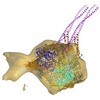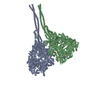[English] 日本語
 Yorodumi
Yorodumi- EMDB-2633: Outer arm dynein dimer from mouse respiratory cilia in pre-power ... -
+ Open data
Open data
- Basic information
Basic information
| Entry | Database: EMDB / ID: EMD-2633 | |||||||||
|---|---|---|---|---|---|---|---|---|---|---|
| Title | Outer arm dynein dimer from mouse respiratory cilia in pre-power stroke (SH-P) | |||||||||
 Map data Map data | subtomogram averaging of dynein dimers from mouse respiratory cilia in the SH-P form (pre-power stroke) | |||||||||
 Sample Sample |
| |||||||||
 Keywords Keywords |  dynein / dynein /  ATP / ATP /  cilia / cilia /  cryo-electron tomography cryo-electron tomography | |||||||||
| Biological species |   Mus musculus (house mouse) Mus musculus (house mouse) | |||||||||
| Method | subtomogram averaging /  cryo EM / Resolution: 40.0 Å cryo EM / Resolution: 40.0 Å | |||||||||
 Authors Authors | Ueno H / Bui KH / Ishikawa T / Imai Y / Yamaguchi T | |||||||||
 Citation Citation |  Journal: Cytoskeleton (Hoboken) / Year: 2014 Journal: Cytoskeleton (Hoboken) / Year: 2014Title: Structure of dimeric axonemal dynein in cilia suggests an alternative mechanism of force generation. Authors: Hironori Ueno / Khanh Huy Bui / Takuji Ishikawa / Yohsuke Imai / Takami Yamaguchi / Takashi Ishikawa /  Abstract: The mechanism by which the two different heads of the ciliary outer dynein arm produce force to translocate the microtubule during beating is still unknown. In this report we use cryo-electron ...The mechanism by which the two different heads of the ciliary outer dynein arm produce force to translocate the microtubule during beating is still unknown. In this report we use cryo-electron tomography and image processing to analyze the conformational changes and the relative abundance of each conformation of the two dynein heads from mouse respiratory cilia. In the absence of nucleotides the majority of dynein dimers are in the apo form and both heads are tightly packed, whereas they are dissociated and move independently in the presence of nucleotides. The head of the external outer arm dynein heavy chain has a diagonal shift toward both the neighboring B-tubule and the proximal end of the axoneme, while the head of the internal heavy chain shifts only longitudinally toward the proximal end. In the presence of nucleotides a significant number of the dynein dimers have two heads overlapped in the proximal shifting form or overlapped in the apo form. During ciliary bending axonemal dynein translocates microtubules by moving with short steps and two heads stay at the same position longer than cytoplasmic dynein. This demonstrates that the step of the outer arm dynein dimer is not dominated by the hand-over-hand motion, but also indicates the difference between axonemal dynein and cytoplasmic dynein. | |||||||||
| History |
|
- Structure visualization
Structure visualization
| Movie |
 Movie viewer Movie viewer |
|---|---|
| Structure viewer | EM map:  SurfView SurfView Molmil Molmil Jmol/JSmol Jmol/JSmol |
| Supplemental images |
- Downloads & links
Downloads & links
-EMDB archive
| Map data |  emd_2633.map.gz emd_2633.map.gz | 9.8 MB |  EMDB map data format EMDB map data format | |
|---|---|---|---|---|
| Header (meta data) |  emd-2633-v30.xml emd-2633-v30.xml emd-2633.xml emd-2633.xml | 9.3 KB 9.3 KB | Display Display |  EMDB header EMDB header |
| Images |  image2633.tif image2633.tif | 759.5 KB | ||
| Archive directory |  http://ftp.pdbj.org/pub/emdb/structures/EMD-2633 http://ftp.pdbj.org/pub/emdb/structures/EMD-2633 ftp://ftp.pdbj.org/pub/emdb/structures/EMD-2633 ftp://ftp.pdbj.org/pub/emdb/structures/EMD-2633 | HTTPS FTP |
-Related structure data
- Links
Links
| EMDB pages |  EMDB (EBI/PDBe) / EMDB (EBI/PDBe) /  EMDataResource EMDataResource |
|---|
- Map
Map
| File |  Download / File: emd_2633.map.gz / Format: CCP4 / Size: 11.9 MB / Type: IMAGE STORED AS FLOATING POINT NUMBER (4 BYTES) Download / File: emd_2633.map.gz / Format: CCP4 / Size: 11.9 MB / Type: IMAGE STORED AS FLOATING POINT NUMBER (4 BYTES) | ||||||||||||||||||||||||||||||||||||||||||||||||||||||||||||||||||||
|---|---|---|---|---|---|---|---|---|---|---|---|---|---|---|---|---|---|---|---|---|---|---|---|---|---|---|---|---|---|---|---|---|---|---|---|---|---|---|---|---|---|---|---|---|---|---|---|---|---|---|---|---|---|---|---|---|---|---|---|---|---|---|---|---|---|---|---|---|---|
| Annotation | subtomogram averaging of dynein dimers from mouse respiratory cilia in the SH-P form (pre-power stroke) | ||||||||||||||||||||||||||||||||||||||||||||||||||||||||||||||||||||
| Voxel size | X=Y=Z: 7.25 Å | ||||||||||||||||||||||||||||||||||||||||||||||||||||||||||||||||||||
| Density |
| ||||||||||||||||||||||||||||||||||||||||||||||||||||||||||||||||||||
| Symmetry | Space group: 1 | ||||||||||||||||||||||||||||||||||||||||||||||||||||||||||||||||||||
| Details | EMDB XML:
CCP4 map header:
| ||||||||||||||||||||||||||||||||||||||||||||||||||||||||||||||||||||
-Supplemental data
- Sample components
Sample components
-Entire : dynein dimer in the SH-P form (pre-power stroke)
| Entire | Name: dynein dimer in the SH-P form (pre-power stroke) |
|---|---|
| Components |
|
-Supramolecule #1000: dynein dimer in the SH-P form (pre-power stroke)
| Supramolecule | Name: dynein dimer in the SH-P form (pre-power stroke) / type: sample / ID: 1000 / Number unique components: 1 |
|---|
-Supramolecule #1: Cilia
| Supramolecule | Name: Cilia / type: organelle_or_cellular_component / ID: 1 / Oligomeric state: dimer / Recombinant expression: No |
|---|---|
| Source (natural) | Organism:   Mus musculus (house mouse) / Strain: C57Bl/6 / synonym: house mouse / Tissue: trachea / Cell: epidermal / Organelle: cilia Mus musculus (house mouse) / Strain: C57Bl/6 / synonym: house mouse / Tissue: trachea / Cell: epidermal / Organelle: cilia |
-Experimental details
-Structure determination
| Method |  cryo EM cryo EM |
|---|---|
 Processing Processing | subtomogram averaging |
| Aggregation state | cell |
- Sample preparation
Sample preparation
| Grid | Details: Quantifoil holey grids |
|---|---|
| Vitrification | Cryogen name: ETHANE / Chamber humidity: 100 % / Chamber temperature: 100 K / Instrument: FEI VITROBOT MARK IV / Method: Blot for 2 seconds before plunging |
- Electron microscopy
Electron microscopy
| Microscope | FEI TECNAI F20 |
|---|---|
| Electron beam | Acceleration voltage: 200 kV / Electron source:  FIELD EMISSION GUN FIELD EMISSION GUN |
| Electron optics | Calibrated magnification: 19303 / Illumination mode: FLOOD BEAM / Imaging mode: BRIGHT FIELD Bright-field microscopy / Cs: 1.5 mm / Nominal defocus max: 5.0 µm / Nominal defocus min: 3.0 µm / Nominal magnification: 30000 Bright-field microscopy / Cs: 1.5 mm / Nominal defocus max: 5.0 µm / Nominal defocus min: 3.0 µm / Nominal magnification: 30000 |
| Specialist optics | Energy filter - Name: GIF Tridiem / Energy filter - Lower energy threshold: 20.0 eV / Energy filter - Upper energy threshold: 25.0 eV |
| Sample stage | Specimen holder: 626 / Specimen holder model: GATAN LIQUID NITROGEN / Tilt series - Axis1 - Min angle: -60 ° / Tilt series - Axis1 - Max angle: 60 ° |
| Temperature | Min: 90 K / Max: 100 K / Average: 95 K |
| Date | Dec 14, 2010 |
| Image recording | Category: CCD / Film or detector model: GATAN ULTRASCAN 1000 (2k x 2k) / Average electron dose: 40 e/Å2 |
| Experimental equipment |  Model: Tecnai F20 / Image courtesy: FEI Company |
- Image processing
Image processing
| Final reconstruction | Applied symmetry - Point group: C1 (asymmetric) / Algorithm: OTHER / Resolution.type: BY AUTHOR / Resolution: 40.0 Å / Resolution method: OTHER / Software - Name:  IMOD / Number subtomograms used: 61 IMOD / Number subtomograms used: 61 |
|---|
-Atomic model buiding 1
| Initial model | PDB ID: |
|---|---|
| Software | Name:  Chimera Chimera |
| Details | AAA domains, stalk, and buttress are considered as a rigid body. Only the linker was flexibly fitted. |
| Refinement | Space: REAL / Protocol: FLEXIBLE FIT |
 Movie
Movie Controller
Controller











